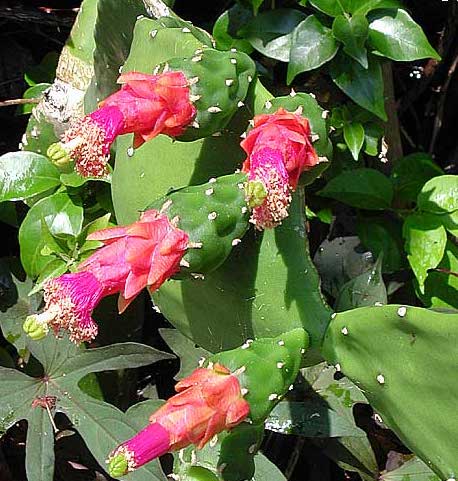
Nopales blossoms will turn to purple fruit. Photo by Green Deane
Nopalea Cochenillifera: Cactus Cuisine
Be brave when you collect cactus.
Of course, good gloves and tongs help. With those tools you can have a very steady and nutritious supply of a tasty wild edible, and not only in warm areas. Cactus grow from Alaska to Argentina, or chilly Canada to chilly Chili, and other parts of the world. People have been eating Nopalea/Opuntia for at least 9,000. It’s not too late to join them.
For example, Opuntia, the most common of the edible cactuses, is native to every U.S. state except Maine, New Hampshire, Vermont and Hawaii, the four states farthest from its native area, Central America (yes, Opuntia are native to southern Alaska and have become naturalized in Hawaii.) That said, I seem to remember seeing some growing in southern Maine in the woods when I was a kid, and I can remember the exact spot. So if not native, they did survive there. Some other families of cactus with edible members are Cereus, Hylocereus and Saguaro. There is probably an edible cactus near you. It also might be healthy: A close cousin, Opuntia Ficus-Indica, seems to have good effects on blood lipids. It also has antioxidants and might help in repair of DNA. O. ficus-indica is the cactus most often found for sale in stores.
Here in Florida there are several kinds of edible cactus. A very common one I have planted in my yard — but can be found growing wild everywhere — is Nopalea cochinellifera, (Noh-PAL–ee-uh koh-ken-ill-EE-fer-uh) also called the cochineal cactus. It was Opuntia cochinellifera (oh-PUN-she-ah koh-ken-ill-EE-fer-uh) but was given it own genus. It can grow in to a 12-foot tree-like cactus and requires much trimming to keep it in check. Both the fruit and the pads are edible after de-spining. Many references say the N. cochinillifera has no spines but they ar wrong. It has little tuffs stuffed with microscopic needles called glochines or glochids (best remove by a blast of water, and or burning off. Hot wax as last resort or duct tape.) “Glochis” is a Greek word meaning “the point of an arrow.” If you get one in your finger you’ll understand.
I got my Nopalea 19 years ago the true forager way. I was in Daytona Beach going to their annual Greek Festival. While walking on the sidewalk I saw one pad — technically a cladode. It had broken off a parent plant and lay on the walkway. I took it home, you know, be kind to homeless plants and all that. Now I have several N. cochinillifera and more cactus than the neighborhood can eat.
Besides food, the blossoms of the N. cochinillifera are a wonderful fuschia. They attract bees, butterflies and those rare little feathered helicopters, hummingbirds. The pear-shaped fruit are ripe when deep red to purple. A large cactus can have virtually hundreds of fruits
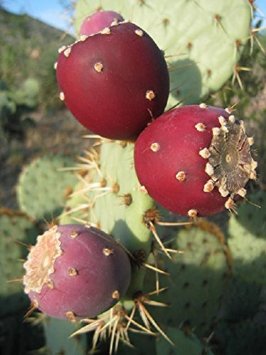
Fruit pulp tastes like raspberries.
Harvesting: The best thing to do is spray fruits and pads with water to reduce the amount of glochids. Pick the fruit with heavy leather gloves then wash them again and or burn what spines there might still remain off — a butane torch works well, a candle flame, or a deftly held propane torch. You then peel them for the soft red fruit flesh inside. It can be eaten raw or cooked and has a raspberry like flavor. Just be sure to take the seeds out. They are very hard and can break your teeth. Grind them into flour. I use often use the cactus fruit to make a salad dressing, especially when I am making a backyard salad. The pads are treated the same way, eat them as is or peeling them and eating the inner part of the pad, raw or cooked. Some say it is an acquired taste but I don’t think the flavor is that far out of the mainstream to say that. Besides everything other than mother’s milk is an acquired tasted. If you can get the spines off you can also eat the outer part of the pad. Just as the Nopalea has a history behind it so to does its name. Let’s take the species name first.
Cochenillifera in Latin means “cochineal bearing” but is from the Greek word for red, “kokinos.” That’s because the cochineal insect lives off that particular cactus and others in the family. That might be almost interesting except you may have eaten that exact insect at one time, or more specifically, a product produced from their crushed, little dehydrated bodies: Cochineal dye. Actually, only the female cochineal provides the red dye and it takes some 75,000 to make one pound, 155,000 to the kilogram. Sometimes in the wild you will see a Nopalea or Opuntia pad flecked with white gray, or even covered with white or gray cotton. That’s a cochineal condo. The hard part is each of the scale-like insects has to be harvested by hand, when they are around 90-days old.
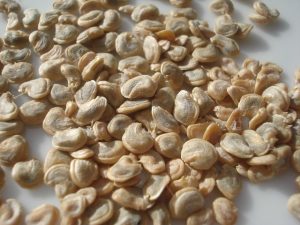
These cactus seeds are tough and need to be ground or roasted.
Until artificial dyes were invented, cochineal dye was the main red dye from food to fabrics. In the 1400s, eleven cities conquered by Montezuma each paid a yearly tribute of 2000 decorated cotton blankets and 40 bags of cochineal dye. During colonial days Mexico had a monopoly on cochineal dye and it was that country’s second largest export after silver. Cochineal went out of favor and flavor when chemical dyes came in but the organic movement and rejection of artificial dyes has brought it back. Cochineal trumps chemicals, as it were. If you use a cosmetic or have eaten a product with any of these ingredients, you have used or bitten the bug: Cochineal extract, carmine, crimson lake (or lac) natural red 4, C.I. 75470, E120, or even “natural coloring” when the product is any shade of red, scarlet or orange. Cochineal is one of the few water-soluble dyes that resist fading.
The genus name, “nopal” means cactus in Nahuatl, the language of the Aztecs, wrongly reported as “Spanish” for cactus. No, the Aztecs had the word first. Opuntia, however, is very removed from the New World. It is from a Greek word, Opos. Opos is an area near Lokria on the island of Euboea, which is northeast of Athens. The Greeks say the island’s name as EH-via (see how Latin has perverted the Greek it imported.) Evia is a favorite get away and one end of the island is only about 100 tidal-torn feet from the mainland. In the Opos area, according to Pliny and Theophrastus, there grew a spiny plant. There also grew figs. Figs are one of the few foods with a latex sap that we can eat (see Natal Plums.) That sap was used as rennet in making cheese. Rennet makes the solids in the milk separate from the liquids so it can be made into cheese. The adjective form of the opos is opuntios, meaning “of Opos.” It came to mean fig-shaped. The cactus, which has spines and a fig-shaped fruit (kind of) got named Opuntios. That was then degraded via Latin to Opuntia, and where I get linguistically irritated when it comes to English. The original word is Greek and is spelled with a T. The T is pronounced as a T, not an S. Yet when you say “oh-PUN-tia” there is always someone around who will try and correct you with “oh-PUN-see-ah.”
Incidentally that cheese-making technique was mentioned in the Iliad and later by Aristotle. It was used well into the 1800s until bacterial ways were found to curdle milk. The technique was so common it was mentioned in several farming “books” by ancient Greeks and Romans.
Opuntia littoralis was introduced to Mediterranean area long ago and flourishes in its mild climate, such as in the south of France, southern Italy, and Sicily where it is a culinary speciality called ficurinnia. In Greece the fruits are called frangosyka (French figs) or pavlosyka (Paul’s figs). The prickly pear also grows in Malta where it is a typical summer fruit and used to make the popular liqueur, Bajtra. There the opuntia is a common dividing wall between Maltese fields.
Nopalea is good for you. There is some lab evidence that it lessens low-density cholesterol, though not reported is whether that was large molecule LDL or small molecule LDL. It’s the small molecule LDL that harms (as of this writing.) The exact nutritional value is not set with several sources giving differing amounts. But, it is low in calories and sodium, high in fiber and vitamin C. It also helps control blood sugar and, according to lab work, reduces the effects of a hangover if eaten before drinking. One word of caution, besides avoiding the spines: Never eat any part of any cactus that has white sap.
Below are some recipes, though they are as common on the internet as spines on a cactus. One note of forecaution: Eating ripe opuntia fruits can turn ones urine reddish. Thought you’d like to know rather than it be a surprise. My two favorite ways of preparing Opuntia/Nopales pads is to pick young ones, brush off the glochids, julienne the pads, and fry in oil. Or, grill them and put them in a sandwich. Delicious. Of course, you can always skip the cactus collecting and give Nopales a try from the can or with commercially harvested pads. Both are found in many supermarkets these days. And let me be honest, I used to cheat a little. Many times when I was serving a dish of a “wild” food — to a group known to have a few squeamish people in it — I would actually buy the “wild” product in the local market, keeping the receipt. That way if someone said they got sick from the “wild” food it was 1) highly unlikely or 2) the grocer’s problem not mine.
Scrub cactus pads well, remove any spines. Cut around the spiny nodules and remove them, completely. (Not necessary with young thin pads. Use whole) Grill the leaves over charcoal for 10 to 12 minutes per side. Thicker pads take longer. Brush pads with oil occasionally while grilling. Serve hot.
Cactus Jelly
One to two quarts or so of cactus fruit (1.5 pounds)
3 cups sugar
1/2 cup lemon juice**
6 ounces liquid fruit pectin Boiling water
Cheesecloth
Place fruit in a large saucepan or kettle. Cover with boiling water, allow to stand for 2-3 minutes, and pour off water. (This aids in softening stickers of the fruit.) Peel fruit, cut into pieces, and place in a medium-sized saucepan. Cover fruit with water and boil at high heat for 5 minutes. Pour boiled mixture through cheesecloth. Drain as much juice as possible. Discard seeds. Measure juice. Combine cups of cactus juice, sugar , and lemon juice in large saucepan. Bring mixture to a rolling boil. Reduce heat to medium-high, add liquid pectin, and cook mixture for 8-12 minutes, or until the mixture begins to thicken. Skim off any foam that may have formed. Pour mixture into hot, sterilized, canning jars and seal as usual. Process jars immersed in a Boiling Water Bath for five minutes to seal the lids.
Cactus Monterey
1 pound cactus pieces
1 small tomato
1/4 small white onion
1 jalapeno pepper
1/4 bunch cilantro
1/4 cup shredded Monterrey jack cheese (or of choice)
1 teaspoon salt (optional)
4 tablespoons avocado or low heat olive oil
Steam the cactus until softened. Drain the cactus. Lightly fry all the other ingredients except for the Monterrey Cheese. Combine fried ingredients with the cactus and allow to simmer for 15 minutes. Top with cheese before serving.
CACTUS FLOWER WINE by Jack B. Keller, Jr.
- 2-1/2 quarts firmly-packed cactus flowers
- 2 lbs granulated sugar
- 1 11-oz can 100% white grape juice concentrate, frozen
- 1-3/4 tsp acid blend
- 1/8 tsp grape tannin
- 6-1/4 pints water
- 1 crushed Campden tablet
- 1 tsp yeast nutrient
- 1 pkt Champagne wine yeast
Wash the flowers and put in nylon straining bag with a dozen marbles for weight, tie bag, and place in primary. Heat 1 quart water and dissolve sugar. Cool with frozen grape juice concentrate and remaining water and add to primary. Add remaining ingredients except yeast and stir well. Cover primary and wait 10-12 hours before adding activated yeast. Recover primary and stir daily. When specific gravity drops to 1.020, drip-drain bag and transfer wine to secondary. Affix airlock and set aside. Rack after 45 days and again after another 45 days, topping up and refitting airlock each time. If fermentation has finished, wine should be clear or begin to clear, although pollen will continue to settle for another 1-2 months. Rack again 60 days after wine has cleared, top up and reattach airlock. Set aside another 90-120 days to bulk age. Stabilize, sweeten to taste and rack into bottles. May taste after 6 months in bottle.
Green Deane’s “Itemized” Plant Profile
IDENTIFICATION: Nopalea/Opuntia can usually be distinguished by flat, rounded pads that are actually jointed stems. They’re usually covered with two kinds of spines, fixed brittle needles and tiny glochids that stick to you instantly. Blossom vary greatly from bottle brush to rose-like. They are a large family, two genera, so learn your local varieties. Duct tape is good for glochid removal, or hot wax.
TIME OF YEAR: Blossoms in spring or summer in some climes, year round in others, pads edible year round, fruit in season.
ENVIRONMENT: They grow from northern Canada to southern South America, rainy Florida to dry deserts.
METHOD OF PREPARATION: Young pads are edible whole. Older pads are usually peeled or have spine eyes removed. The best pads are shiny and not too thick. They get fiberous then woody as they age. The inner flesh of the red fruit is edible having a flavor similar to raspberries. Juice from the inner fruit can be used as is or made into ade or jelly. The hard seeds must be ground before eating. The inner flesh of some pads of many if not most species is also edible, can be sour. If your cactus has milky sap. DON’T EAT IT. You’ve got the wrong plant.

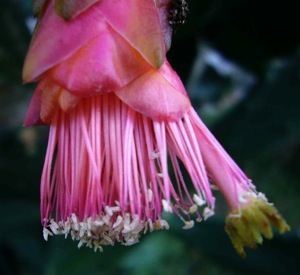
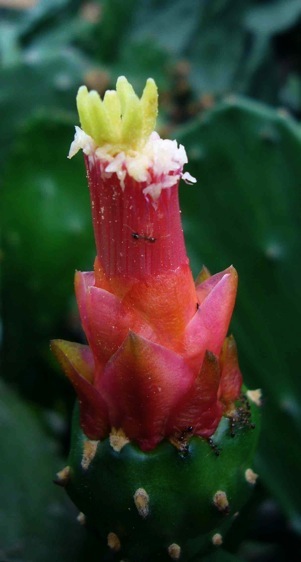
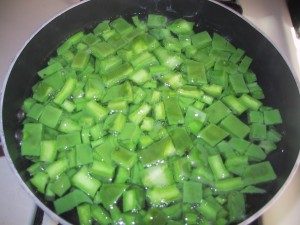
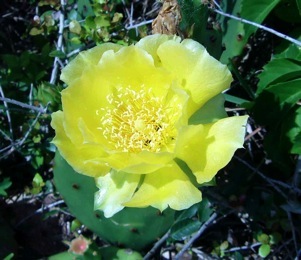
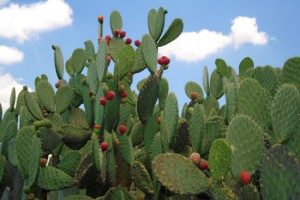
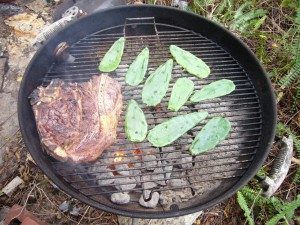

I am quite interested in trying to grow an nopalea cocherillifer cactus.Where can I purchase part of the plant or seeds.
Gosh, they grow everywhere. I can send you some but first I would google Feral Kevin (or look up his email address in my Foraging Insructors page.) He lives out where you do and might have some suggestions.
I live in Jensen Beach and there are Bauhinias everywhere. Anyways, I decided to pick some seed pods today after coming across your blog. Once I found a tree I stopped and parked nearby. To my surprise, there was a cactus growing beneath the tree with a single yellow blossom. I picked the blossom and ate it on the spot. It was good, light and sweet with a touch of bitterness. I didn’t take any of the pads because I didn’t want to deal with the spines, but it did make me wish there was more than one blossom!
I just found what appears to be Opuntia humifusa (yellow flowers, not red) in Baltimore in early June. Maybe this was deliberately planted. It has spread more horizontally than vertically. (One to two feet high and 20 feet across. No trees, like you see in Green Deane’s “Bon Appetit” video.)
Anyway, delicious. I had some 2-inch pads raw. I took a bite and kept going. I picked six-inch long pad, julienned it, and pan fried for about five minutes with olive oil, garlic and jalapeno. Just fabulous. Next I’ll try grilling.
Thanks, G.D. I never would have tried this.
-cw
I live on Roanoke Island in the Outer Banks of NC and I find these cactus all over the beaches right next to just about every beach access.
Cool thing is,
Theyre like a native tiny version! [that is unless its too late after you juts ran through a field] Also its not uncommon for folks to have the domestic kinds [I’ve seen at least 2 different species the more common one has rounder pads and the other has somewhat more elongated slanted shape to it, fruits taste exactly the same] at businesses, in rock gardens or completely taking over though I wonder if people realize it’s such good food! I got a gang of friends at the beach one day to try fruit mind you I dont think any of these kids had ever eaten anything that wasn’t from a restaurant or store and everyone at least ate it and didnt spit it out or complain!
I love to eat the fruits and often just swallow the seeds whole.
I don’t think you really mentioned it but the entire flower is edible as well! It is very sweet, has a most unique flavor and is somewhat fleshy but thin and covered in pollen.
Ive yet to even get to cookin these things other than once in an omelet with some hot peppers which was most amazing. I usually just eat the pads raw right away! They kinda taste like slimy okra or maybe green beans!
Also I for sure second the gloves & tongs advice
Great website Deane
Be blessed
if you don’t grow them today, grow them tomorow. you will never regret it.
would like seeds where can I get some
Usually one plants a pad rather than seeds. The pads grow quite quickluy.
So are all types of opuntia rufida edible? Even the ones called bever tail or bunny ears ones. Are there any type that is not edible? I have seen one without the spines to ones covered in spines. How do we tell what exactly is and which one arent?
I have read that all opuntia are edible. Their palatabilty, however, varies greatly.
I enjoyed ready your site. I lived in Mexico City for a few years and began buying and eating the pads and the fruit in the local fruit markets. Today I live in the sierra of central Argentina and the land I bought to build my home was full of this cactus. I enjoy the fruit but have a hard time peeling them and love the flowers when they are in bloom. Thank you for sharing.
What we do in Bermuda is pick the pads skin it then soak in water overnight then drink the water cooling effect on blood is awesome also helps with constipation
hai,
i am from india. farmers state chairman, working for welfare of farmers.i personally felt very happy after seeing yours information. but is not enough to me to guode the farmers. requesting to send some more information regarding harvest and thair techniques . thank you sir.
Hi i have a nopales cactus in my front yard it is so big that the ice has laid it down it is about 5ft tall the roots are so big, when the weather gets back hot will it stand back up.
Oh sorry i live in oklahoma.
If deer are a problem in your garden, this is a GREAT plant to grow. I grew a big patch in the middle of a deer-filled woods by just dumping a pile of sand there and sticking pads in it. One deer took one bite out of a pad ONCE……and it never happened again.
actually, deer, goats, and sheep love cactus, sorry to say. it’s actually used as forage in some (dryer) countries. we use it here in California to supplement our grass fed sheep. but it may depend on the length of the spines in your particular species. the pines on our Opuntis are quite short. no doubt, the cacti with very long spines are more inhibiting to grazers…
Would like some body to post me some recipies.
I would like to know where can I find the fruit
I am pregnant and I really wanna this fruit I live in CT
I hope some one help me!
i need to plant green cactus in my back yard(tuna) do you sell this young tree(pads) how much it cost to ship it to virginia
No, I don’t sell plant or parts. But a local nursery should be able to help you.
I just want to say that I have just read you entire page on the cactus fruits, flowers, and pads. I am a big fan of anything you guys write. You really know your stuff. I have recently made some chicken fajitas with fried cactus pads. It was more than amazing. I also have tried making some drinks with the prickly pear. Thanks to the info you all have shared on the site. Thanks for the awesome info. I hope you keep making topics and teaching the world about stuff like this. Have a good one. And god bless.
I wonder about pickles, like pickled okra
Hi! cactus fruit is an interesting .Thank you for your description .
Dear i want to know about the protein,energy and other nutrient content of this fruit.
Please send to me important point by mail.
I look for your email
I have a Nopalea Cochenillifera in my yard in Florida. I am having a problem with the plant. The pads (leaves) are turning a grey colour along the edges and look like they are rotting or being eaten by an insect or bug of some sort. Does anyone know the cause of this problem and how to solve it. Is there anything I can spray the plant with to get rid of the infestation? I would appreciate any advice you might give me….Jim
I covered that issue in the article extensively. It’s the little bugs they use to make dye.
This is the first “wild” this New England transplant tried upon moving to FL (SW) and is still a huge favorite! Drop a pad anywhere and these things will grow, which is a good thing! There are very thorny varieties that stay smallish, but my favorites are obviously the bigger, tamer ones! Only thing is, for whatever reason, though they bloom like mad and have lots of young fruit, they never mature and ripen! Any thoughts? Kind of frustrating as none of the plants around here that are similar will set fruit!
Oh yeah and a separate issue…some of the pads on a few plants are bright red! I also noticed some signs of the insect, could this be related to the cochineal dye they produce? Curious why it would be isolated to just a few pads.
Eeek, one more question? I know you aren’t a nutritionist, but I was wondering if maybe you could direct me to a source of knowledge about traditional plants vs. agricultural. I was wondering about a lot of the recipes that recommend vigorously rinsing the “nopales” after boiling to reduce the mucilaginous texture. It’s known nopales are great for diabetics and seems to me the rinsing would remove a lot of the beneficial properties inherent in them, one of which just may be in that thick sap that they want us to do away with.
I turned my health around in the last few years and lately have been doing a lot of my own culturing and fermenting veggies and other stuff, and these cactus are an awesome ingredient, alone or in combination, as in a fermented salsa or pica de gallo! Fermentation is a natural preservation process with a result similar to pickling, only much healthier because it created the probiotics our guts need to digest food and fuel our immune systems! Great stuff! Google it, it is so worth it! It’s life altering, I mean it!
I have not found young nopales overly mucilaginous.
Charzie, I know your post is from 2015. Your post expresses some good opinions, and encourages me. I’ve been having some arthritic issues lately, as well as some digestive problems. Reading about the pickling was great. I’ve made Kimchi. I grew up eating the cactus, “nopale,” is what they’re called in my culture….Mexican. As to your comment regarding the rinsing of the cacti after the cooking process, I was talking to some women from Mexico at a gathering who had brought a salad with cactus. I hadn’t made it in quite awhile, hence needed to refresh my memory about the cooking process, and wanted to know about nutritive aspect too. One woman said she was eating more cactus since she was trying to control her blood sugar and for weight loss. She advised that when you boil it for instance, don’t throw out any of that liquid. Some nutrients end up in this water. I understand, that many people just don’t seem to understand the value this gel/mucilage has in the pads, and want to get rid of it. But actually, that’s a rather dumb move if you’re after nutrition, or addressing health issues. All right, hope you read here again.
My Nopales Cactus has picked up some type of blight. The trunk and limbs look like they have been eaten by some type of bug and they are becoming hollow in some places and turning a grayish brown color. Does anyone have the same problem or can anyone tell me what is happening and how I can correct the problem. Is there a spray I can make or purchase that will get rid of the problem? Thanks for any help you might offer………Jim
You know, the awesome thing about Mexican gastronomy, is, much like European gastronomy, very waste-free. old dough for bread becomes sourdough, old grape juice to wine, etc. Even corn when covered in “smut” becomes an edible masterpiece, not to mention the various insects which are supposedly great for nutrition coming from agricultural plants. What you are likely referring to must be the cochineal insect, which is a powerful parasite that takes on the cactus plant, which has been domesticated for an important use. Although it takes on every growing point or spine of nopales, you know you have it when you take off a fuzzy part which when with a bug gets squeezed, blood-red juices come gushing out like a nasty pimple. That, my friend, is the source of natural red dye.
It may destroy your plant, as I have seen one infected which grew mold all over and was cut down, but if diluted vinegar doesn’t control it, I would recommend enjoying it, and making sure there is space between the plant and other plants since it feeds off the new growth, which are the sources of food for us (future fruits and nopales pads). Enjoy!
If you are in FL or the humid Deep South, it might be due to caterpillars of the invasive Cactoblastis moth (which some idiot impatient with native cactus thickets introduced to the Caribbean, then it hitchhiked here). If you find caterpillars in the cavities, that’s the culprit. If you are not gardening for butterflies (it kills all lepidoptera), Bacillus thuringensis will kill the insect without rendering the cactus poisonous to you.
For the BT to work, the caterpillars have to eat it. Since they are inside the pads, it’s very hard to do. Perhaps some sort of injector could work? I recommend removing affected parts and throwing them in a big fire, or maybe your oven if you can’t have fires where you are.
I love this article. We were lucky enough to buy property with plenty of cacti growing and thriving. I have become very found of the paddles, both cloned and raw. I am so grateful that I can maintain my own vegetable supply as I do not have a green thumb and can not seem to keep most plants alive.
Great page.
I have a few of the Cochanilliafera in my yard. They flower with the long narrow tube red blossoms, which wither, die and the plump base shrivels, dies and falls off, too. Eventually a new pad grows. But no fruit! What do I need to do to make it have fruit? The one tree is 12′ already. I LOVE cactus fruit and thought since it was a form of opuntia or prickly pear it would have fruits. I hear they do. So what am I doing wrong? Or is it not big enough ? Please help!
I have seen what I believe you are talking about. unfortunately in my climate I have never seen fruit grow on those varieties… it could be that there is only one cloned variety which is male, and it needs a female, it could be anything, but what I would recommend is to get a standard fat-leaved variety growing on a hill by your local mexican neighborhood- those usually work, just don’t take mine hehe
I have heard that all cactus fruit is edible. Is that true?
If they have pads and no white sap, yes.
Does that same rule apply to the pads, or are some pad bearing clear sap cacti unsafe to eat for the pads?
The main point is to avoid white sap in spiny plants such as cactus.
two questions. Is the nopalea cocherillifer the same cacti that we call “pan cactus” ( flat and rounded) ? And, can I freeze prepared cacti for later use or will it ruin it?
Thanks
I just had a question, since you enjoy all kinds of varieties of plants I assume, have you enjoyed or found a difference in the different varieties of cactus fruit? or the pads? the one you pictured grilling is a strange variety i have growing myself (I have a collection myself) and I have found, as with others that that variety does not produce fruits on it. not fruits that ripen to red or any colors other than green that is, any thoughts? it seems like the cactus that grow the fastest leaves don’t produce well on the fruiting side, I plan on growing primarily for fruits while only enjoying a few nopales now and again, and am curious to the conditions or varieties which support more fruits than more leaves, thanks
I have these cacti all over my area. However, they are very often shriveled, moreso in the winter for some reason. They also very rarely set off new pads. Are they still ok to eat?
If you are in a cold/cool climate, it is normal for cacti to shrivel a bit in winter. They pump water out their roots and into the soil, because excess water is likely to freeze. Ice has more volume than water, so ice formation would rupture cells and vascular tissue, potentially killing the plant. Likewise, just because something is evergreen doesn’t mean it will be in active growth all year. Wait till spring for new pads.
Hi Dean,
I’ve been growing O. cohenillifera for many years. I’ve almost never encountered a thorn or glochid on them. I’ve also never seen one produce a fruit that looks good to eat. They’re always these shrunken little things, that fall off and I don’t think they ever turn red. I think we’re growing different kinds of cacti.
I also grow a thorny kind, but not ficus-indica. I think it might be stricta. They make some delicious bright red fruits in the fall. I’ve bought tuna cactus fruits in grocery stores and didn’t think they were much worth eating. I wonder what people do with those.
Anyway, the thorns and glochids of the ripe fruits are easily rubbed off with a few paper towels. I find no need to go for flame throwers and whatnot. The pads are a different story though. This kind has very formidable thorns and glochids and can be quite a pain in the everywhere. That’s why I stick with the cochenillifera for the vegetable parts.
Spineless cactus, without stickers(or spines) is available online.Luther Burbank bred a spineless cactus,which hucksters became involved with, and began a scam like the Dutch tulip craze.Burbank wasn’t much of a businessman and was ridiculed by allowing such to happen.People like Helen Keller and Rockefeller were fans. Today there is a move to use cactus as a fuel for cars.Cactus has been found to have neuroprotective capabillity. The FAO has done a large study listing the products and uses for man and animal,water purification and a way to halt desertification.
Pliny and Theophrastus never described the plant from Opos as being spiny. They merely said that it was edible and could be propagated by rooting the leaves. Theophrastus did not call the plant ‘opuntios.’ The name ‘opuntia’ first appeared in some copies of Pliny and may not have been used by Pliny himself.
I’m in the Hudson Valley in NY. I see what we call “prickly pear” in people’s yards on occasion. I’ve also see these on the tops of local hills and rock outcroppings along the river. They produce fruits that become red, and sometimes the pads are red or become red in the colder season.
However, they are never very raised or tall. Rather, they tend to be very low lying or flat to the ground as a ground cover. Different variety? I can’t imagine that we have two varieties of wild cactus here in New York…
I have the joy of living in Arizona. The nopal did a number, producing tons of fruit. so much, birds and animals can’t keep up, and most folks have gallons of juice. Juice is a natural concentrate, 5 cups water, half a cup of juice, and it tastes about like watermelon. If the pads are picked small, the thorns are usually soft. Yes, prickly pear is native to Maine. https://downeast.com/images/maine-hardy-prickly-pear-cactus/ claims it, anyway. And its always a shock for some peeping tom when he steps in a cousin’s patch up to Bangor. Always a good read on your posts. Much thanks. niio
No, they are not native to Maine. They will grow there if you plant them which I did in the early 70’s. But they are not native.
I have several different types of cactus in my yard. They all seem to fit the edible prickly pear descriptions. I have only found toxic cacti that looked very different from mine. I have a spineless variety that is variegated and one that isn’t. If I am right, they are both edible Nopalea / Opuntia cochenillifera specimens. Are there any toxic look-alikes?
The key is white sap which usually means a toxic species.